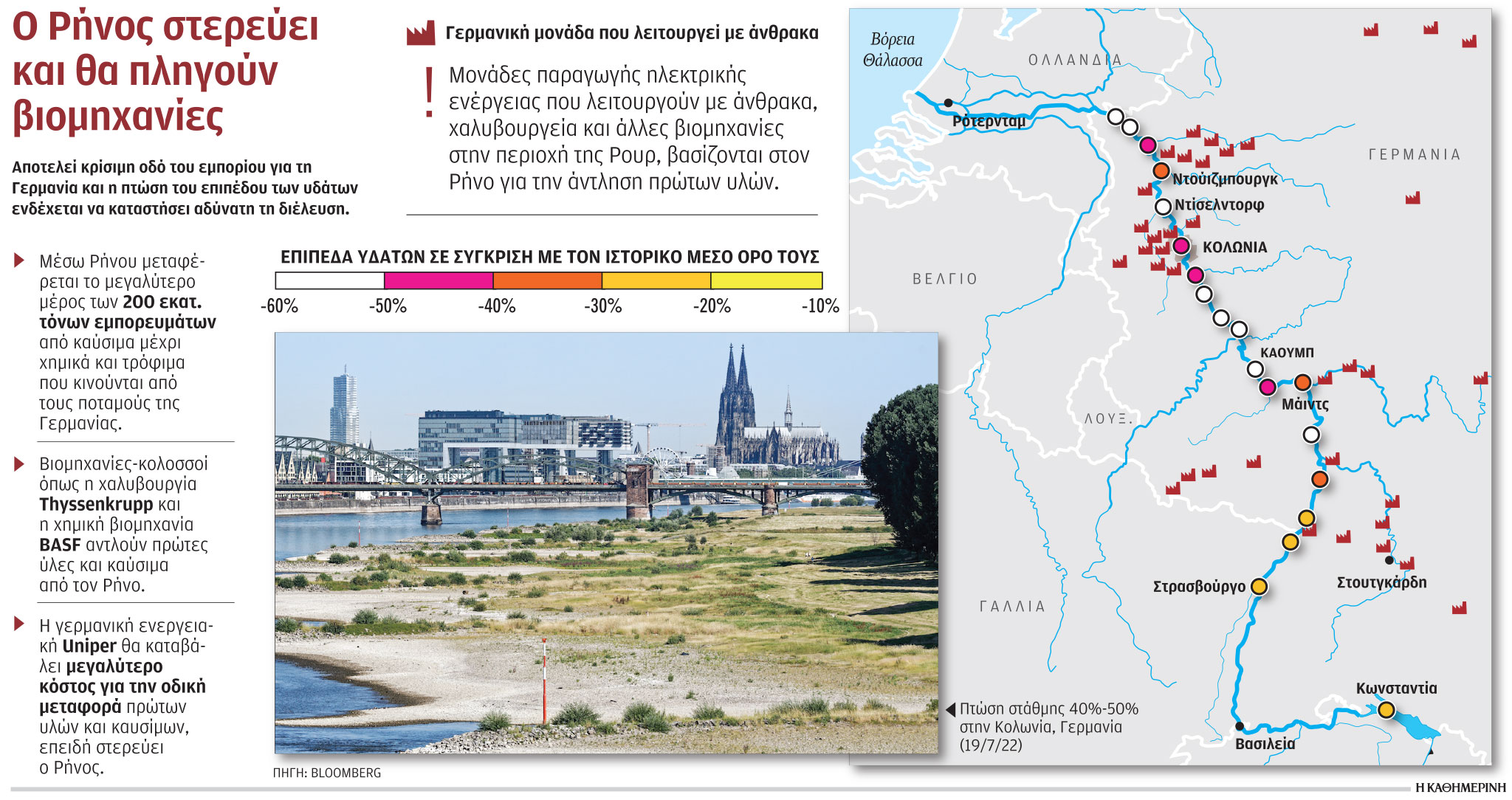
Four years ago, the water level in the Rhine dropped so much that the symbolic river, which is the backbone of the economy of Germany, as well as the Netherlands and Switzerland, ceased to be navigable in all its parts. The situation led to disruptions in the floating trade in fuels, raw materials and food and a loss of 5 billion euros. This summer, the same devastating scenario is not only repeating itself, but is spreading to water levels across Europe, threatening a much greater impact on its economy.
The old continent is facing a drought that is causing rivers to dry up, canals to dry up and hydroelectric power stations to deplete. From Norway and Switzerland to Serbia and Romania, the authorities are anxious and rush to take action, and from the Rhine to the Danube and the Po, rivers are drying up. This means that Europe risks losing a key source of energy in the midst of an energy crisis, losing the waterways of an important part of trade, including the transport of fuel, and suffering even in the specialized sectors of its tourism and its gastronomy. The irony is that rivers and canals are included in the EU plan. for the transition to a “green” economy, since the transportation of goods along the rivers is less polluting.

The loudest wake-up call came from Norway when it announced that the country would henceforth stop exporting energy resources to the EU.
The loudest alarms sounded earlier this week from Norway, when Energy and Petroleum Minister Terge Åsland said the country’s hydropower supplies had dried up so much that the country would now stop exporting energy to the EU. when the waters recede below the level to provide enough electricity for his households and businesses. Unlike many European countries, the Scandinavian country has seen a 25% increase in domestic electricity consumption as the use of fossil fuels is limited and the transition to electric vehicles is encouraged. Thus, Europe is losing a stable energy supplier at the very moment when it is looking for alternative sources in an attempt to replace the much-indispensable Russian gas.
The news coincided with two equally ominous statements by French energy company Electricite de France and Germany’s Uniper. The French energy company said it would cut the capacity of its nuclear power plants near the Rhone and Garonne rivers as the water level dropped and its temperature rose, making it unsuitable for cooling nuclear reactors. A new hurdle has come at a time when about half of France’s nuclear reactors are not being repaired. On the same day, Germany’s Uniper announced that it would likely be forced to cut production at two of its coal plants as transport of fuel across the Rhine was disrupted by a significant water level retreat.
Water shortage brings Italian agricultural production to its knees
Undoubtedly, the end of floating trade on the Rhine will be much more decisive for the German economy in particular, as well as for the Netherlands and Switzerland. At the same time, however, the drop in the Po River to its lowest level recorded in the last 70 years is affecting the Italian economy, both in its agricultural production, tourism, and even gastronomy.
The decrease in the water level in the Po River also affects tourism.
Primarily because the Po Valley accounts for about 30% of the country’s agricultural production and is currently suffering from extreme heat and drought. As a result, the harvest of corn and sunflower is reduced, and farmers are forced to limit their planting, as there is not enough water from the Po for irrigation. In a delta formed by a river south of Venice, water shortages have caused a kind of algal wilt. But the worst thing is that for the growth of clams and mussels there is not enough water or oxygen. And as farmers and fishermen of the region very characteristically note in the Italian media, as the number of shellfish and mussels decreases, Italians and tourists will miss the famous seafood pasta, one of the most famous and popular dishes of Italian cuisine. vongole. Around 30% of the area’s shellfish have been lost since the start of this summer, according to local fishermen, and at least 2,300 fishermen and other shellfish-farming professionals are at risk of losing their jobs. That is why the unions of all these workers, in this extremely difficult political situation, are asking for government intervention.
Tourists, on the other hand, are simply asking for rain because even tourism is suffering from falling water levels in Europe’s rivers and canals. The problem has recently been felt in the Bavarian city of Passau, known as the “city of three rivers”, since the Danube forms a delta here, meeting the waters of the Inn from the south and Ilyich from the north. Yet the city risks losing its reputation and its tourist glamour. At the end of July, a 135-meter cruise ship with more than 130 passengers, which is supposed to sail in the waters of three rivers, collided with an obstacle due to their very low water levels. Therefore, tourists were forced to fly from Bucharest.
Warning in Germany, the transport of raw materials and fuel across the Rhine is under threat
“The rivers of Europe will not lose their bad name as transport routes, but rather they will become less reliable waterways in the future.” This is a prediction by Fred Hattermann, an expert on hydro-climatic risks at the Potsdam Institute for Climate Research. An ominous and worrying prognosis as the rivers of Europe as a whole contribute around 80 billion euros, mostly as waterways for transport, as tons of goods are transported along them, which equates to at least one ton per year for every EU citizen. It is certain, however, that the Rhine is the most important river in Europe and, for the Germans, approaches the size of a mythological symbol. For centuries, it has been the backbone of the economies of Germany, the Netherlands and Switzerland.
It plays a key role in transporting coal to German power plants and is a physical link to Europe’s inland waterway network. About 58 million people live in the wider Rhine area and use it for drinking water, irrigation, recycling and energy production. First of all, it is indispensable for some industries such as the ThyssenKrupp steel industry and the BASF chemical industry, as it is the waterway through which fuel, diesel, coal and raw materials are transported to the industries. It is also indispensable given Germany’s outdated infrastructure, its usually congested rail network with its traffic chaos, and the country’s equally congested road network. After all, at least 110 trucks will be required to transport cargo carried by a medium-sized transport vessel across the waters of the Rhine, and let’s not forget that after the pandemic, Germany needs 80,000 truck drivers.
Around the river live 58 million people who use it for drinking water, irrigation, processing and energy production.
At the moment, the waters of the Rhine are at a lower level than they were exactly four years ago, in the summer of 2018. According to the Economic Institute of Kiel, then the suspension of trade along the river brought about 0.4% of the German total GDP.
According to Niels Jansen, an economist at the Kiel Institute, the damage caused by falling waters is the first sign that we can begin to calculate today the damage that the German and possibly the European economy will suffer precisely because of the drying of the Rhine. . Realizing the severity of the problem, Thyssenkrupp has staffed a crisis response team and is assessing the situation daily, while BASF is looking for alternative channels to get raw materials and fuel to its plants. The Rhine, connected to the Danube by a canal, is 1,287 kilometers long and passes through the industrial zones of Switzerland and Germany before emptying into the North Sea at the busy port of Rotterdam in the Netherlands. As for the Danube, the fall of its waters caused alarm in Bulgaria, Romania and Serbia. Dredging, bottom and depth measurements are being urgently carried out in three countries to determine the ability of ships to navigate the waters of the river. As a result, ships stand in line for days.

Oslo is worried
Indicating Norway’s concerns about the impact of water depletion, Oil and Energy Minister Terge Åsland stressed earlier this week that “the government is prioritizing filling up hydro storage for this and will stop energy exports when supplies drop to a very low level.”

Serbia
Worried about the water levels in the Danube, Serbia’s Minister of Infrastructure stressed that “it is critical to the energy supply that the Danube remains navigable, as cargo ships carry coal down the river to power power plants when hydroelectric production is reduced.”

In France
Earlier this week, French energy giant EdF announced a temporary reduction in the capacity of its nuclear power plants on the Rhone and Garonne rivers as rising water temperatures made them unsuitable for cooling nuclear reactors.
Source: Kathimerini
Lori Barajas is an accomplished journalist, known for her insightful and thought-provoking writing on economy. She currently works as a writer at 247 news reel. With a passion for understanding the economy, Lori’s writing delves deep into the financial issues that matter most, providing readers with a unique perspective on current events.